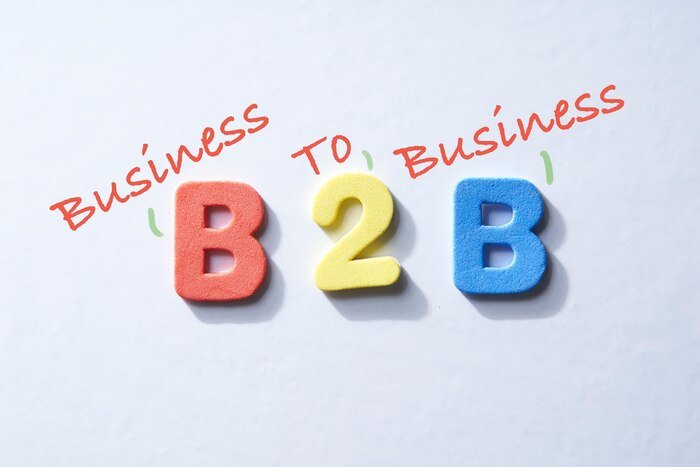How B2B and B2C business models differ: 10 key features
-
Svetlana Sibiryak
Copywriter Elbuz
There are two business models - B2B and B2C. Essentially the same, but at the same time so different! It is these differences that are important for understanding and making strategic decisions in marketing sales. 10 key factors will change your entire vague outlook into a high-quality and promising business. Discover these differences and you'll never look at business the same way again! 🔥
Glossary
- B2B (Business-to-Business) - a business model in which organizations enter into transactions and interact with each other, providing goods or services exclusively for other companies, and not for end consumers.
- B2C (Business-to-Consumer) - a business model in which companies sell goods or services directly to end consumers, bypassing intermediaries.
- Legal registration is the process by which a new business is officially registered with government agencies in order to legally operate and provide goods or services.
- Online store website is a virtual platform that allows users to view and purchase goods or services provided by the company.
- Content - information material that is created by a company to attract and retain potential clients or customers.
- Product handling - the process of preparing and managing an assortment of goods or services, including purchasing, warehousing, packaging and delivery.
- Personnel - company employees who are responsible for performing various functions and tasks in business processes.
- Documentation - official documents presenting information about a business, such as contracts, invoices, deeds, etc.
- Customer Communication - the process of interaction with customers, including processing requests, feedback, support and improving relationships with customers.
- Promotion - marketing strategies and tactics used by a company to increase brand awareness, attract new customers and increase sales.
- Payment for goods - the process of making payment for goods or services provided by the company.
- Entry threshold - the level of complexity required to interact with a company to find solutions or make a purchase.

.png)
B2B and B2C: 10 Key Differences
In this section, we'll look at 10 key differences between B2B (business-to-business) and B2C (business-to-consumer) business models that will help you define your marketing and sales strategy. Let's dive deeper and discover how these differences can impact your business.
1. Target audience
In the B2B business model, your customers are other companies. You offer your products or services to meet the needs of other entrepreneurs. On the other hand, in the B2C model, you serve direct consumers, the end users of the product or service.
2. Sales and Marketing Strategy
In a B2B business, sales and marketing strategy are developed taking into account the specifics of the work and the needs of other businesses. Here the emphasis is on long-term relationships and personalizing the offer for each client. In B2C business, the strategy is built around attracting and retaining a wide audience, often using mass communication channels and marketing approaches.
3. Sales volumes
B2B businesses work with wholesale sales volumes, concluding large transactions with a limited number of customers. In the B2C sphere, on the contrary, sales have a smaller structure and occur with a larger number of consumers.
4. Suppliers and Customers
In the B2B business model, suppliers and customers are organizations that typically have professional expertise and specialized knowledge. In the B2C sphere, consumers for the most part do not have professional expertise and are looking for simple solutions to their needs.
5. Duration of Relationship
B2B relationships are usually long-term and based on established partnerships. While B2C consumers rarely sign long-term contracts, their decisions and purchases are largely driven by immediate demands and preferences.

6. Requirements and features
B2B clients are often more demanding in terms of product quality and services, as they are entrepreneurs and expect a level of professionalism from the supplier. While B2C clients more often order goods or services based on emotions and intuition.
7. Sales Cycle
B2B sales typically have a long cycle that involves many steps and interactions before the customer makes a purchasing decision. B2C sales, on the other hand, are often completed in a significantly shorter time frame and require fewer steps.
8. Resource Requirements
B2B businesses require significant resources to scale operations and establish long-term partnerships. This may include investments in production capacity, logistics, warehousing, etc. B2C business, although it has a wider audience, can make do with easier resources.
9. Marketing channels
In the B2B sphere, specialized marketing channels are used, such as B2B online portals, exhibitions and conferences, specialized magazines and advertising in professional MASS MEDIA. In the B2C sphere, broader marketing channels are used, such as social networks, advertising on TV, radio and other mass channels.
10. Financial Risks
B2B businesses come with greater financial risks as they typically deal with larger amounts and long-term relationships. B2C businesses are typically less exposed to financial risks as they have lower transaction volumes and benefit from tighter contract terms.
🔥 Review: Significant differences between B2B and B2C
| B2B ✔️ | B2C ✔️ |
|---|---|
| Clients - companies | End-user clients |
| Long-term relationships | Short-term solutions |
| Wholesale sales volumes | Small sales structures |
| Quality and professionalism requirements | Emotional and intuitive decisions |
"Progress is not stops, and our goal is to meet all customer needs, no matter how difficult the situation becomes." - B2B and B2C expert Lesya Ogienko, Electron concern, Ukraine
Takeaway: Apply B2B and B2C
After learning the key differences between B2B and B2C business models, you can apply what you learn to your own marketing and sales strategy. Consider the characteristics of your target audience, select appropriate marketing channels and develop a personalized approach for each type of business.
Now that you understand the key differences between B2B and B2C business models, you can apply this knowledge to your marketing and sales strategy. Choose the most suitable model, develop your marketing strategy and achieve business success!
✔️ If you are interested in opening your own business in Ukraine, pay attention to the registration of an Individual Entrepreneur (PE). Find out more about the process of opening a sole proprietorship in our article.

What is the difference between B2B and B2C ?
B2B and B2C are types of business models that have their own unique features and differences. To fully understand the difference between them, let's look at each model in more detail.
B2B (Business-to-Business)
B2B is a business model in which goods or services are provided to businesses and organizations. In this case, the clients are other companies, not end consumers. B2B stores engage in wholesale sales by trading with other businesses.
B2B stores require their own or rented premises for storing goods, since the quantity of products can be significant. In addition, they have more complex warehouse management and special requirements for packaging goods. It is important to note that B2B companies often have multiple owners and require the management of a large team of specialists.
B2B portals play an important role in this business model by providing a convenient platform for interacting with customers, placing orders and conducting business transactions at a higher level.
You may be interested in our articles about B2B portal , where you will find more detailed information about what role they play in the B2B business model.
Good to know:
- B2B stores engage in wholesale sales.
- Own or rented premises for storing goods are required.
- Stores have special requirements for inventory control and packaging of goods.
- B2B portals make it easier to interact with customers and conduct business transactions.
B2C (Business-to-Customer)
B2C is a business model in which companies offer their goods or services to ordinary to individuals as clients. B2C stores engage in retail trade and sell goods individually or in small quantities.
The main goal of B2C stores is to attract and retain end consumers. To do this, you need to pay special attention to the content and information about the products. High-quality photographs, detailed descriptions and positive customer reviews help make purchasing decisions. B2C stores actively use various methods of promotion on the Internet and social networks to attract new customers.
Good to know:
- B2C stores are engaged in retail trade and sell goods individually or in small quantities.
- Quality content and product information also play an important role in B2C.
- B2C stores actively use online marketing and social networks to attract customers.
🔥 Review: B2B and B2C functionalities
| Variations 📋 | B2B ✔️ | B2C ✔️ |
|---|---|---|
| Wholesale/retail | Wholesale | Retail |
| Warehouse accounting | More complex | Less complex |
| Product packaging | Special requirements | Less creative freedom |
| Content | Not so important, customers usually communicate with the seller | Content influences purchasing decisions |
| Clients | Enterprises and organizations | Ordinary individuals |
| Operations | Complex processes | Simple purchasing process |
Expert Note: “Understanding the differences between B2B and B2C will help you develop an effective marketing and sales strategy. Consider the needs of your target audience and adapt your customer communications to achieve the best results." - Erwin Weber, Thomas, Germany
Conclusion: B2B and B2C - make the right choice!
B2B and B2C are two different business models that have their own unique features and differences. stores are engaged in wholesale sales and require a more complex organization than B2C stores. B2C stores, in turn, are engaged in retail trade and actively use Internet marketing to attract customers.
Choosing between B2B and B2C depends on your goals, audience and business specifics. Understanding the differences between B2B and B2C will help you decide on the choice of business model and develop your own corresponding marketing and sales strategy. Consider the features of each model and effectively apply marketing strategies to achieve results.
In this article, we looked at the differences between B2B and B2C business models. Understanding these differences will help you properly implement effective marketing strategies for your business model.
Geberit expertise
Detailed description of the client, his business and objectives
Geberit is a world leader in the field of sanitary technology and wastewater systems. The company was founded in Switzerland in 1874 and today is one of the leading providers of plumbing solutions worldwide. Geberit's goal is to provide innovative, efficient and environmentally sustainable plumbing solutions for construction and renovation.
One of the company's main goals was to promote and increase sales of B2B products, such as drainage systems for commercial buildings. Geberit also sought to strengthen its market position and increase awareness of its products and solutions.
Identification of the main problem to solve
During the analysis of the market and competitive environment, Geberit » found that low awareness of its products and lack of visibility of the company are the main obstacles to achieving its goals. In addition, it was noted that B2B customers require a more personalized approach and consultation to make purchasing decisions.
Description of the characteristics and interests of the target audience
Geberit's target audience in the B2B segment includes architects, designers, construction companies and plumbing specialists. They are interested in innovative plumbing solutions such as efficiency, eco-friendliness and sustainability. Customers are also looking for a reliable partner that offers high-quality products and technical support.
Key points that may be of interest to potential Geberit customers include:
- Innovative wastewater systems and technologies that promote efficiency resource use.
- High quality products and durability for long service life.
- Convenience and functionality that improve the user experience.
- Ease of installation and maintenance, speeding up the construction or repair process.
Facts, figures and concrete results of the project
Geberit developed an integrated marketing and sales strategy that included the following diverse activities and solutions:
-
Digital Marketing Campaign. A targeted marketing campaign was launched aimed at architects and construction companies. This included creating high-quality content such as blogs, video tutorials and case studies, as well as hosting webinars and online seminars.
-
Content management. The company paid special attention to creating content that reflected the interests and needs of the target audience. They provided useful information on industry trends, examples of successful projects, as well as guides and recommendations on the selection and use of Geberit products.
-
Improved customer service. Geberit has decided to significantly increase its customer support by providing a wider range of services, including consultation, educational programs and product demonstrations.
-
Affiliate programs. The company has partnered with leading architectural firms and construction companies to collaborate on stylish, high-quality projects that use Geberit products.
As a result of these efforts, Geberit achieved the following concrete results:
- Increased product sales B2B segment by 20% over the last year.
- Increase interest and inquiries from potential clients by 30%.
- Strengthening Geberit's position in the sanitary ware market, receiving recognition and awards for innovative products and environmental responsibility.
🔥 Video review: comparison of Geberit toilets. How to choose a toilet?
🔥 Frequently asked questions on the topic: "B2B and B2C: 10 key differences "
-
What is a B2B business model?
-
The B2B (Business-to-Business) business model is a relationship between two or more companies where products or services are intended to be used by the other company.
-
What is a B2C business model?
-
B2C (Business-to-Consumer) business model is a relationship between a company and the end consumer, where products or services are intended for use and consumption by the end user .
-
How does legal registration affect B2B and B2C models?
-
In the B2B model, both parties are required to be legally registered as they represent the companies. In the B2C model, only legal registration of the company providing services or seller of goods is required.
-
How does an online store website affect B2B and B2C models?
-
In the B2B model, an online retailer's site is typically used to provide information about products, while the actual transactions are completed through other means of communication. In the B2C model, the online store website is the main means of selling products or services.
-
How does content matter for B2B and B2C models?
-
In a B2B model, content tends to be more detailed and educational, as buyers often go through a long decision-making process. In the B2C model, content often focuses on creating emotional appeal and directly selling products or services.
-
How does product handling differ in B2B and B2C?
-
The B2B model often involves specific custom requirements, more complex logistics solutions and long-term contracts. In the B2C model, work with goods is usually based on a mass production model, where customer needs are met through a one-time purchase.
-
What features are associated with personnel in B2B and B2C models?
-
The B2B model often requires specialized staff to advise clients on complex issues. In a B2C model, staff must be focused on providing fast and efficient customer service.
-
What is the role of documentation in B2B and B2C models?
-
In the B2B model, documentation has a higher importance, since contracts and other legal documents often need to be drawn up. In the B2C model, documentation requirements are usually less formalized.
-
How does customer communication differ between B2B and B2C models?
-
In the B2B model, communication with customers often occurs through direct contact, meetings and negotiations, as more complex issues may require deeper discussion. In the B2C model, communication with customers often occurs through the website, email, or online chats.
-
How is promotion carried out in B2B and B2C models?
-
In the B2B model, promotion is often carried out through customer relationships, recommendations and the provision of expert information. The B2C model uses a wider range of marketing channels, including advertising, social media and promotions.
-
How do you pay for goods in B2B and B2C models?
-
In the B2B model, settlements typically occur through invoicing and formal payment procedures such as wire transfers or documentary letters of credit. In the B2C model, payments can be made directly during the purchase through various electronic payment systems.
-
What is the entry threshold for B2B and B2C models?
-
The barrier to entry in the B2B model is usually higher, as more time and resources are required to establish long-term business relationships. In the B2C model, the barrier to entry is lower because customers can make a single purchase without preconditions or contracts.
Thanks for reading! Now you are a pro in B2B and B2C!🔥
Congratulations! You've just finished reading our article on 10 key differences between B2B and B2C business models. Now you are no longer a newbie in this field!
You've learned that B2B and B2C have significant differences in their approaches to marketing and sales. You've immersed yourself in their key differences and can now use this knowledge to develop your effective business strategy.
We hope that our article was not only interesting, but also useful for you! Each of us can contribute to a famous store with the help of the knowledge gained in this article. Your colleagues and friends will be amazed by your expert knowledge of the differences between B2B and B2C!
Don't stop there! Use this knowledge and grow your business experience. You have what it takes to succeed in B2B or B2C - take a step forward and achieve your business dream!
Still have questions or comments? Please don't hesitate to contact us. We are always happy to help you with your business needs or problems.
Thanks for reading! Good luck on your entrepreneurial journey! 💼🚀
.png)
🔥 Video review: differences between B2B and B2C marketing
- Glossary
- B2B and B2C: 10 Key Differences
- What is the difference between B2B and B2C ?
- Geberit expertise
- Video review: comparison of Geberit toilets. How to choose a toilet?
- Frequently asked questions on the topic: "B2B and B2C: 10 key differences "
- Thanks for reading! Now you are a pro in B2B and B2C!
- Video review: differences between B2B and B2C marketing
Article Target
Provide information on the differences between B2B and B2C business models
Target audience
Managers, marketing and sales specialists, entrepreneurs
Hashtags
Save a link to this article
Svetlana Sibiryak
Copywriter ElbuzThe magic of words in the symphony of online store automation. Join my guiding text course into the world of effective online business!
Discussion of the topic – How B2B and B2C business models differ: 10 key features
Learn how different B2B and B2C business models differ from each other. This article explores 10 key differences that can impact your marketing and sales strategy.
Latest comments
8 comments
Write a comment
Your email address will not be published. Required fields are checked *












.jpg)




.png)
John
Interesting article! I think one of the key differences between B2B and B2C is that in B2B selling requires a greater degree of communication and personalization. How do you think?
Ana
I agree with you, John! In B2B sales, sales are increasingly dependent on trust and establishing long-term partnerships. I would also add that in B2C the emphasis is more on the emotions and mass needs of consumers. What do you think, Mark?
Mark
Thank you, Ana! I think another important difference is the complexity of the approach to clients. B2B sales usually require a longer sales cycle and a more thorough analysis of the client's needs. What do you think, Jeanne?
Jeanne
I agree, Mark! In B2C, a deal can be closed with one purchase, but in B2B, it takes a lot of time and effort to convince the customer to cooperate and build a mutually beneficial relationship. I think another key difference is the nature of communication. How do you see this, Martin?
Martin
Hello Jen! I agree with you that in B2B communication is more formal and focused on problem solving and business goals. In B2C, on the contrary, communication is often more informal and emotional. But I also think that product quality and price could also be one of the key differences. What do you think, Jacqueline?
Jacqueline
Hi, Martin! Agree with you! In B2C, consumers often evaluate a product based on its price and quality, while in B2B, functionality, integration, and product support are more important. These differences determine sales and marketing strategy. I'm sure everyone can come up with other key differences!
Gustav
Hello! I believe that all these business models - B2B, B2C, they are all just a waste of time. Trends and key differences are all meaningless! I'm old enough to see how all these innovations are bringing us closer to the end of civilization. Let's enjoy simple things and not waste time on such nonsense!
Olga
Hello Gustav! I understand your point of view, but I believe that we must be willing to change and improve our business models to remain competitive. This has always been the case in the business world. But I also love the simple pleasures of life! To each his own, right?